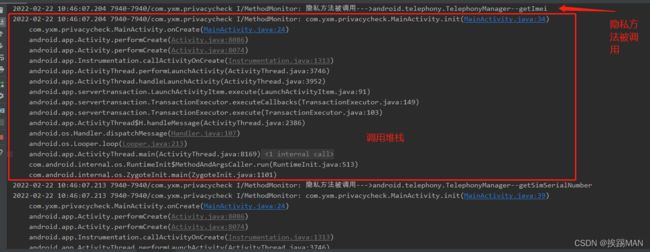- SpringBoot可以同时处理多少请求?
java1234_小锋
javajava开发语言
大家好,我是锋哥。今天分享关于【SpringBoot可以同时处理多少请求?】面试题。希望对大家有帮助;SpringBoot可以同时处理多少请求?1000道互联网大厂Java工程师精选面试题-Java资源分享网SpringBoot本身并不直接限制可以处理的请求数量,能处理多少请求取决于几个因素,主要是底层的Web服务器(如嵌入式的Tomcat、Jetty或Undertow),以及服务器硬件、操作系统
- 说说你对Java里Integer缓存的理解?
java1234_小锋
javajava开发语言
大家好,我是锋哥。今天分享关于【说说你对Java里Integer缓存的理解?】面试题。希望对大家有帮助;说说你对Java里Integer缓存的理解?1000道互联网大厂Java工程师精选面试题-Java资源分享网Java中的Integer缓存是为了提高性能而引入的优化机制,特别是对于频繁使用的小范围整数的情况。具体来说,Integer类对从-128到127范围内的整数值做了缓存。这些整数值被缓存起
- java常用数据转换
bestwinner
javapythonwindows
1.List与数组互转ArrayListlist=newArrayListlist1=Arrays.stream(array1).collect(Collectors.toList());String[]cateArray=cateList.toArray(newString[cateList.size()]);2.new集合对像importcom.google.common.collect.Li
- 开发实战|commons-lang3库的字符串工具类join方法
六月暴雪飞梨花
commons-lang3StringUtilsStringjoin
作者简介:「六月暴雪飞梨花」,专注于研究Java,就职于科技型公司后端工程师近期荣誉:华为云云享专家、阿里云专家博主、腾讯云优秀创作者、腾讯云TDP-KOL、ACDU成员、墨天轮技术专家博主三连支持:欢迎❤️关注、点赞、收藏三连,支持一下博主~文章目录引言来源StringUtils.joinString.join功能对比StringUtils.join支持原生数组支持集合支持迭代器Iterator
- IDEA本地启动flink 任务
Direction_Wind
intellij-ideaflinkjava
1pom中添加org.apache.flinkflink-clients_${scala.binary.version}${flink.version}org.apache.flinkflink-runtime-web_${scala.binary.version}${flink.version}2下载flink-dist包并3打印日志中搜索localhost可以找到flink的管理页面
- [解决] PDF转图片,中文乱码或显示方框的解决方案
DazedMen
开发遇到的问题pdfjavapdf转图片
在Java开发中,将PDF文件转换为图片是一项常见的需求,但过程中可能会遇到中文乱码或显示方框的问题。本文将深入探讨这一问题,并提供详细的解决方案,帮助开发者顺利地完成PDF到图片的转换。一、问题现象在使用Java库(如ApachePDFBox)将PDF转换为图片时,如果PDF文件中包含中文字符,转换后的图片中可能会出现中文乱码或显示为方框的情况。控制台日志可能会显示类似以下信息:noglyphf
- Mybatis和Mybatis-plus常用注解
AWen_X
Java常用框架注解mybatis开发语言java后端springbootspring
Mybatis和Mybatis-Plus常用注解一、Mybatis常用注解1.@Select注解说明:标记查询语句,用于定义查询操作的SQL语句。代码示例:@Select("SELECT*FROMusersWHEREid=#{id}")UsergetUserById(@Param("id")Longid);注解处理类:由org.apache.ibatis.builder.annotation.Ma
- 【Kafka高级】Kafka性能优化与调优实践
全栈追梦人
kafka性能优化linq
在大规模数据处理和实时消息传递场景中,Kafka的性能优化至关重要。本文将从生产者性能优化、消费者性能优化以及集群性能调优三个方面展开,结合实际代码示例和配置参数,帮助读者更好地理解和应用Kafka性能优化策略。一、生产者性能优化Kafka生产者的性能直接影响消息发送的效率和系统的吞吐量。以下是一些关键优化策略:1.1批量发送生产者会将消息批量发送到Kafka,减少网络请求次数。以下参数对批量发送
- 耦合与解耦:软件工程中的核心矛盾与破局之道
以恒1
软件工程
耦合与解耦:软件工程中的核心矛盾与破局之道在软件开发领域,耦合与解耦是贯穿始终的核心矛盾。它们如同硬币的两面,既相互对立又紧密依存。本文将从概念解析、类型分类、解耦策略到实际应用,全面剖析这对矛盾体的本质与破局之道。一、耦合的本质:依赖关系的多维透视耦合(Coupling)指软件系统中不同模块、组件或服务之间的相互依赖程度。这种依赖可能表现为数据传递、控制流交互或资源共享。根据耦合强度,可分为七种
- MyBatis 中 resultType 的使用详解
旧故新长
windows
MyBatis中resultType的使用详解1.resultType的含义在MyBatis中,resultType指的是每一行查询结果的Java类型,而不是整个结果集的类型。常见的用法:resultType="java.lang.String":表示每一行是一个字符串。resultType="com.example.User":表示每一行是一个User对象。2.resultType与方法返回值类
- 第二十九篇 数据仓库与商务智能:技术演进与前沿趋势深度解析
随缘而动,随遇而安
数据库数据仓库大数据数据库架构数据库开发
声明:文章内容仅供参考,需仔细甄别。文中技术名称属相关方商标,仅作技术描述;代码示例为交流学习用途,部分参考开源文档(Apache2.0/GPLv3);案例数据已脱敏,技术推荐保持中立;法规解读仅供参考,请以《网络安全法》《数据安全法》官方解释为准。目录一、核心差异:技术定位与实现路径1.1核心能力矩阵二、协同关系:现代数据供应链的双引擎2.1数据价值链协同2.2典型技术栈集成三、前沿技术动态(2
- java Spring Boot ruoyi-vue-pro 模型接入微软 OpenAI(chatgpt)方法
代码简单说
开发必备2025开发必备java若依ruoyi教程javaspringbootvue.jsruoyi-vue-proopenaichatgpt大模型
javaSpringBootruoyi-vue-pro模型接入微软OpenAI方法本项目基于SpringAI提供的spring-ai-azure-openai,实现与微软Azure上部署的OpenAI的接入,涵盖AI对话和AI绘画功能。1.申请密钥1.1AzureAPI申请在微软AzureAI申请。社区小伙伴提供过密钥接入,申请流程应不复杂。申请完成后会得到类似模型列表(如图)。购买完成后,在系统
- C语言异常处理就机制setjmp()和longjmp()
red98
C语言基础知识c语言开发语言
C语言setjmp()和longjmp()实现异常处理机制。setjmp()用于保存当前的程序执行状态。longjmp()用于在后面的某个时刻返回到setjmp()点的状态。类似goto。但goto是本地的,只能在函数内部跳转。setjmp()和longjmp()是非局部跳转语句,可在调用栈上,返回到调用路径上的某一个函数中。头文件#include#includestaticjmp_bufbuf;
- 【K8S】ImagePullBackOff状态问题排查。
执键行天涯
K8skubernetes容器云原生
ImagePullBackOff是在使用Kubernetes(K8s)时经常遇到的一种错误状态,下面为你详细介绍其含义、可能的原因及解决办法。含义当你在K8s集群中创建一个Pod时,Kubelet会尝试从指定的镜像仓库拉取所需的容器镜像。如果拉取镜像失败,Kubelet会进行重试。随着重试次数的增加,重试的间隔时间会逐渐变长,这就是所谓的“指数退避”策略。当Kubelet多次尝试拉取镜像都失败后,
- 一文弄懂Python 变量初始化与内存管理
宇寒风暖
python编程python开发语言笔记学习
在Python中,变量的初始化并不一定会开辟新的内存空间。Python的内存管理机制非常灵活,它会根据变量的值、类型以及Python的内部优化策略来决定是否复用已有的内存空间。1.变量初始化的基本概念在Python中,变量是对象的引用。当你初始化一个变量时,Python会执行以下操作:创建一个对象(如果该对象不存在)。将变量名绑定到该对象。例如:a=10b="hello"a是一个整数对象的引用。b
- CLR 线程池
Jditinpc
windows
一、线程池基础线程池是应用程序能使用的线程集合。每CLR一个线程池;这个线程池由CLR控制的所有AppDomain共享。如果一个进程中加载了多个CLR,那么每个CLR都有它自己的线程池。CLR初始化时,线程池中没有线程。线程池维护了一个操作请求队列。创建和销毁线程是一个费时间的操作。应用程序执行一个异步操作时,就调用某个方法,将一个记录项追加到线程池的队列中。线程池的代码就从这个队列中提取记录项,
- BRAM消耗与FIFO的关系:有效利用FPGA资源的策略
kanhao100
HLSfpga开发
BRAM消耗与FIFO的关系:有效利用FPGA资源的策略引言在FPGA设计中,BRAM(BlockRAM)是用于存储数据的重要资源。有效管理和利用BRAM对于实现高性能数字系统至关重要。特别是对于需要频繁读写数据的应用,FIFO(先进先出)缓冲区的使用与BRAM的消耗之间存在着密切的关系。本文将探讨BRAM的消耗、FIFO的特性,以及如何正确利用BRAM以优化设计效率。1.BRAM的基本概念1.1
- 收集整理了一些wordpress开发中常用到的实用代码
wodrpress资源分享
wordpresswordpress
wordpress调用全站热门文章代码”,‘post_status’=>‘publish’,//只选公开的文章.‘post__not_in’=>array($post->ID),//排除当前文章‘caller_get_posts’=>1,//排除置顶文章.‘orderby’=>‘comment_count’,//依评论数排序.‘posts_per_page’=>$post_num);$query_
- 13 异常处理的使用大全
希望_睿智
C++基础知识精讲c++windowsc语言开发语言异常处理
概述异常是指程序在执行的过程中,没有按照预定的流程和逻辑去运行,从而导致数组越界、内存溢出、甚至程序崩溃等各种非正常的情况。在C++、Java和C#等高级语言中,都提供了对于异常的处理机制。异常处理,实际上是一种转移程序控制权的方式。当程序中抛出了异常时,我们可以捕获异常,进而进行相应的处理。处理模型一般有两种:一种是终止模型,表示该异常是致命的,无法恢复,会直接终止程序;另一种是恢复模型,表示该
- 【FAQ】HarmonyOS SDK 闭源开放能力 —Push Kit(10)
1.问题描述:离线推送,锁屏的时候没有弹出消息,只有下拉在通知中心里面显示。请问是否是正常的?解决方案:检查一下是否存在图片风控:https://developer.huawei.com/consumer/cn/doc/harmonyos-refere...2.问题描述:1.请问纯鸿蒙系统的远程推送,自分配如何配置?2、纯鸿蒙系统的远程推送,有没有高透传?3、Android华为推送如果切到鸿蒙推送
- Python静态方法
Frank_Yee
python
在Python中,静态方法是一种不会自动接收类(cls)或实例(self)作为第一个参数的方法。它可以通过类直接调用,而不需要类的实例。静态方法通常用于实现与当前类的对象状态无关的功能,或者提供一些通用的工具函数。一、使用场景1.工具函数:当方法不需要访问对象属性或类属性时,可以将其定义为静态方法。2.常量类:有时候,你可能需要一个类仅仅作为一个容器,用来存储常量。3.工厂方法:在某些情况下,你可
- Node.js 格式化时间的两种方法:原生 Date 与 npm 包 moment 详解
还是鼠鼠
node.jsnode.jsnpm前端javascriptvscode
目录Node.js格式化时间的两种做法:内置方法与npm包1.使用JavaScript内置方法格式化时间示例:使用Date对象格式化时间运行程序示例输出原理解析2.使用npm包moment进行时间格式化安装moment示例:使用moment格式化时间运行程序示例输出原理解析3.两种方法的对比4.结论在Node.js开发中,格式化时间是一个常见的需求。例如,将时间格式化为YYYY-MM-DDHH:m
- day11 学习笔记
豆豆
学习笔记python
文章目录前言一、类方法二、静态方法三、构造方法四、魔术方法前言通过今天的学习,我掌握了更多Python中有关面向对象编程思想中方法的概念与操作,包括类方法,静态方法,构造方法,魔术方法一、类方法类方法是属于类的行为,一般使用类而非对象进行调用类方法需要使用@classmethod装饰器定义类方法至少有一个形参用于绑定类,约定为cls类和该类的实例都可以调用类方法,但一般不用实例进行调用类方法不能访
- java NIO中的FileSystems工具类可以读取本地文件系统,ZIP/JAR等,无需解压处理,还可以复制文件
爱的叹息
Java基础整理javaniojar
在JavaNIO(java.nio.file包)中,FileSystems是一个工具类,用于操作和管理文件系统。它提供了静态方法来获取或创建文件系统实例,并支持自定义文件系统实现。以下是其核心功能和用法:1.核心功能(1)获取默认文件系统获取当前运行环境的默认文件系统(如本地文件系统):FileSystemfileSystem=FileSystems.getDefault();(2)创建新的文件系
- 没有好的学历,Java开发未来的路应该怎么走?
全干程序员demo
技术热文java开发语言
没有好的学历,Java开发未来的路应该怎么走?在当今数字化时代,技术发展日新月异,大模型应用、鸿蒙系统等新兴技术领域正在蓬勃发展,为Java开发者带来了新的机遇和挑战。即使没有高学历,Java开发者依然可以通过以下路径在这些新兴领域找到自己的发展方向,实现职业突破。一、拥抱新兴技术,拓宽技术边界(一)大模型应用:从开发到优化大模型技术正在重塑软件开发的各个环节。对于Java开发者来说,可以从以下几
- DeepSeek带来服务器与显卡需求激增的核心逻辑
DeepSeek+NAS
人工智能服务器运维网络安全计算机网络
随着DeepSeek等开源AI模型的普及,个人开发者和小型企业正加速构建私有化AI服务器,以处理敏感数据和定制化任务。这种趋势不仅重构了算力需求的结构,更推动服务器和显卡市场进入新一轮增长周期。以下从技术迭代、行业需求、市场格局三个维度展开论述。一、私有化部署:从数据安全到算力自主的核心驱动力数据隐私与合规性需求公共AI平台的数据泄露风险促使企业选择本地化部署。例如,医疗机构的患者数据、金融企业的
- 如何区别原生页面和H5页面
大汉堡玩测试
功能测试
文章目录前言原生开发特点H5开发特点混合开发怎么区别是原生还是H5总结前言软件采用混合开发的模式时,测试发现了bug找开发沟通有时会找错人,明明是H5模块的错误却找了负责原生模块的开发,显得很不专业~那在测试时该如何区分是原生的报错还是H5报错呢?原生开发原生开发(NativeApp开发),是为特定操作系统(如iOS使用Objective-C/Swift、安卓使用Java/Kotlin)专门开发的
- APP怎么抓取原生日志 - Android篇
大汉堡玩测试
android功能测试
文章目录前言为什么要抓原生页面的日志举一个抓取原生日志的例子AndroidDebugBridge(ADB)安装ADB连接设备验证连接抓取日志注意点总结前言好困~写点我觉得重要的吧,IOS和HarmonyOSNEXT这周写为什么要抓原生页面的日志原生日志能够捕捉到与操作系统和应用框架交互的关键信息,包括性能瓶颈、崩溃报告和安全事件等,而这些是纯H5日志无法提供的,确保了对应用行为的全面监控和精准调试
- YOLOv12优化:图像去噪 | AAAI2025 Transformer |一种基于Transformer的盲点网络(TBSN)架构 ,结合空间和通道自注意力层来增强网络能力
AI小怪兽
YOLOv12魔术师YOLOtransformer深度学习人工智能python
提出了一种基于Transformer的盲点网络(TBSN)架构,通过分析和重新设计Transformer运算符以满足盲点要求。TBSN遵循扩张BSN的架构原则,并结合空间和通道自注意力层来增强网络能力。如何使用:1)结合C3k2二次创新使用;2)结合A2C2f二次创新使用;亮点包括:1.提出了一种新的基于Transformer的盲点网络(TBSN)架构;2.引入了知识蒸馏策略来提高计算效率;3.在
- 什么是MCP?看不懂你打我
X.Cristiano
深度学习MCP
什么是MCP?MCP是一种协议,它实现了大模型资源调用的标准化。千百年来,随着人类社会的发展,标准化的进程不断推进。大模型与外部资源的对接同样需要标准化,MCP正是为此而生!接下来的文字,或许,将帮助你奶奶明白MCP对于她意味着什么。2011年,微信发布。想象一下,你奶奶刚开始用微信。那时,还没有小程序。她的体验或许是这样的:第一个月,她惊喜地发现微信能订电影票了!再过一个月,她发现微信又能约出租
- java封装继承多态等
麦田的设计者
javaeclipsejvmcencapsulatopn
最近一段时间看了很多的视频却忘记总结了,现在只能想到什么写什么了,希望能起到一个回忆巩固的作用。
1、final关键字
译为:最终的
&
- F5与集群的区别
bijian1013
weblogic集群F5
http请求配置不是通过集群,而是F5;集群是weblogic容器的,如果是ejb接口是通过集群。
F5同集群的差别,主要还是会话复制的问题,F5一把是分发http请求用的,因为http都是无状态的服务,无需关注会话问题,类似
- LeetCode[Math] - #7 Reverse Integer
Cwind
java题解MathLeetCodeAlgorithm
原题链接:#7 Reverse Integer
要求:
按位反转输入的数字
例1: 输入 x = 123, 返回 321
例2: 输入 x = -123, 返回 -321
难度:简单
分析:
对于一般情况,首先保存输入数字的符号,然后每次取输入的末位(x%10)作为输出的高位(result = result*10 + x%10)即可。但
- BufferedOutputStream
周凡杨
首先说一下这个大批量,是指有上千万的数据量。
例子:
有一张短信历史表,其数据有上千万条数据,要进行数据备份到文本文件,就是执行如下SQL然后将结果集写入到文件中!
select t.msisd
- linux下模拟按键输入和鼠标
被触发
linux
查看/dev/input/eventX是什么类型的事件, cat /proc/bus/input/devices
设备有着自己特殊的按键键码,我需要将一些标准的按键,比如0-9,X-Z等模拟成标准按键,比如KEY_0,KEY-Z等,所以需要用到按键 模拟,具体方法就是操作/dev/input/event1文件,向它写入个input_event结构体就可以模拟按键的输入了。
linux/in
- ContentProvider初体验
肆无忌惮_
ContentProvider
ContentProvider在安卓开发中非常重要。与Activity,Service,BroadcastReceiver并称安卓组件四大天王。
在android中的作用是用来对外共享数据。因为安卓程序的数据库文件存放在data/data/packagename里面,这里面的文件默认都是私有的,别的程序无法访问。
如果QQ游戏想访问手机QQ的帐号信息一键登录,那么就需要使用内容提供者COnte
- 关于Spring MVC项目(maven)中通过fileupload上传文件
843977358
mybatisspring mvc修改头像上传文件upload
Spring MVC 中通过fileupload上传文件,其中项目使用maven管理。
1.上传文件首先需要的是导入相关支持jar包:commons-fileupload.jar,commons-io.jar
因为我是用的maven管理项目,所以要在pom文件中配置(每个人的jar包位置根据实际情况定)
<!-- 文件上传 start by zhangyd-c --&g
- 使用svnkit api,纯java操作svn,实现svn提交,更新等操作
aigo
svnkit
原文:http://blog.csdn.net/hardwin/article/details/7963318
import java.io.File;
import org.apache.log4j.Logger;
import org.tmatesoft.svn.core.SVNCommitInfo;
import org.tmateso
- 对比浏览器,casperjs,httpclient的Header信息
alleni123
爬虫crawlerheader
@Override
protected void doGet(HttpServletRequest req, HttpServletResponse res) throws ServletException, IOException
{
String type=req.getParameter("type");
Enumeration es=re
- java.io操作 DataInputStream和DataOutputStream基本数据流
百合不是茶
java流
1,java中如果不保存整个对象,只保存类中的属性,那么我们可以使用本篇文章中的方法,如果要保存整个对象 先将类实例化 后面的文章将详细写到
2,DataInputStream 是java.io包中一个数据输入流允许应用程序以与机器无关方式从底层输入流中读取基本 Java 数据类型。应用程序可以使用数据输出流写入稍后由数据输入流读取的数据。
- 车辆保险理赔案例
bijian1013
车险
理赔案例:
一货运车,运输公司为车辆购买了机动车商业险和交强险,也买了安全生产责任险,运输一车烟花爆竹,在行驶途中发生爆炸,出现车毁、货损、司机亡、炸死一路人、炸毁一间民宅等惨剧,针对这几种情况,该如何赔付。
赔付建议和方案:
客户所买交强险在这里不起作用,因为交强险的赔付前提是:“机动车发生道路交通意外事故”;
如果是交通意外事故引发的爆炸,则优先适用交强险条款进行赔付,不足的部分由商业
- 学习Spring必学的Java基础知识(5)—注解
bijian1013
javaspring
文章来源:http://www.iteye.com/topic/1123823,整理在我的博客有两个目的:一个是原文确实很不错,通俗易懂,督促自已将博主的这一系列关于Spring文章都学完;另一个原因是为免原文被博主删除,在此记录,方便以后查找阅读。
有必要对
- 【Struts2一】Struts2 Hello World
bit1129
Hello world
Struts2 Hello World应用的基本步骤
创建Struts2的Hello World应用,包括如下几步:
1.配置web.xml
2.创建Action
3.创建struts.xml,配置Action
4.启动web server,通过浏览器访问
配置web.xml
<?xml version="1.0" encoding="
- 【Avro二】Avro RPC框架
bit1129
rpc
1. Avro RPC简介 1.1. RPC
RPC逻辑上分为二层,一是传输层,负责网络通信;二是协议层,将数据按照一定协议格式打包和解包
从序列化方式来看,Apache Thrift 和Google的Protocol Buffers和Avro应该是属于同一个级别的框架,都能跨语言,性能优秀,数据精简,但是Avro的动态模式(不用生成代码,而且性能很好)这个特点让人非常喜欢,比较适合R
- lua set get cookie
ronin47
lua cookie
lua:
local access_token = ngx.var.cookie_SGAccessToken
if access_token then
ngx.header["Set-Cookie"] = "SGAccessToken="..access_token.."; path=/;Max-Age=3000"
end
- java-打印不大于N的质数
bylijinnan
java
public class PrimeNumber {
/**
* 寻找不大于N的质数
*/
public static void main(String[] args) {
int n=100;
PrimeNumber pn=new PrimeNumber();
pn.printPrimeNumber(n);
System.out.print
- Spring源码学习-PropertyPlaceholderHelper
bylijinnan
javaspring
今天在看Spring 3.0.0.RELEASE的源码,发现PropertyPlaceholderHelper的一个bug
当时觉得奇怪,上网一搜,果然是个bug,不过早就有人发现了,且已经修复:
详见:
http://forum.spring.io/forum/spring-projects/container/88107-propertyplaceholderhelper-bug
- [逻辑与拓扑]布尔逻辑与拓扑结构的结合会产生什么?
comsci
拓扑
如果我们已经在一个工作流的节点中嵌入了可以进行逻辑推理的代码,那么成百上千个这样的节点如果组成一个拓扑网络,而这个网络是可以自动遍历的,非线性的拓扑计算模型和节点内部的布尔逻辑处理的结合,会产生什么样的结果呢?
是否可以形成一种新的模糊语言识别和处理模型呢? 大家有兴趣可以试试,用软件搞这些有个好处,就是花钱比较少,就算不成
- ITEYE 都换百度推广了
cuisuqiang
GoogleAdSense百度推广广告外快
以前ITEYE的广告都是谷歌的Google AdSense,现在都换成百度推广了。
为什么个人博客设置里面还是Google AdSense呢?
都知道Google AdSense不好申请,这在ITEYE上也不是讨论了一两天了,强烈建议ITEYE换掉Google AdSense。至少,用一个好申请的吧。
什么时候能从ITEYE上来点外快,哪怕少点
- 新浪微博技术架构分析
dalan_123
新浪微博架构
新浪微博在短短一年时间内从零发展到五千万用户,我们的基层架构也发展了几个版本。第一版就是是非常快的,我们可以非常快的实现我们的模块。我们看一下技术特点,微博这个产品从架构上来分析,它需要解决的是发表和订阅的问题。我们第一版采用的是推的消息模式,假如说我们一个明星用户他有10万个粉丝,那就是说用户发表一条微博的时候,我们把这个微博消息攒成10万份,这样就是很简单了,第一版的架构实际上就是这两行字。第
- 玩转ARP攻击
dcj3sjt126com
r
我写这片文章只是想让你明白深刻理解某一协议的好处。高手免看。如果有人利用这片文章所做的一切事情,盖不负责。 网上关于ARP的资料已经很多了,就不用我都说了。 用某一位高手的话来说,“我们能做的事情很多,唯一受限制的是我们的创造力和想象力”。 ARP也是如此。 以下讨论的机子有 一个要攻击的机子:10.5.4.178 硬件地址:52:54:4C:98
- PHP编码规范
dcj3sjt126com
编码规范
一、文件格式
1. 对于只含有 php 代码的文件,我们将在文件结尾处忽略掉 "?>" 。这是为了防止多余的空格或者其它字符影响到代码。例如:<?php$foo = 'foo';2. 缩进应该能够反映出代码的逻辑结果,尽量使用四个空格,禁止使用制表符TAB,因为这样能够保证有跨客户端编程器软件的灵活性。例
- linux 脱机管理(nohup)
eksliang
linux nohupnohup
脱机管理 nohup
转载请出自出处:http://eksliang.iteye.com/blog/2166699
nohup可以让你在脱机或者注销系统后,还能够让工作继续进行。他的语法如下
nohup [命令与参数] --在终端机前台工作
nohup [命令与参数] & --在终端机后台工作
但是这个命令需要注意的是,nohup并不支持bash的内置命令,所
- BusinessObjects Enterprise Java SDK
greemranqq
javaBOSAPCrystal Reports
最近项目用到oracle_ADF 从SAP/BO 上调用 水晶报表,资料比较少,我做一个简单的分享,给和我一样的新手 提供更多的便利。
首先,我是尝试用JAVA JSP 去访问的。
官方API:http://devlibrary.businessobjects.com/BusinessObjectsxi/en/en/BOE_SDK/boesdk_ja
- 系统负载剧变下的管控策略
iamzhongyong
高并发
假如目前的系统有100台机器,能够支撑每天1亿的点击量(这个就简单比喻一下),然后系统流量剧变了要,我如何应对,系统有那些策略可以处理,这里总结了一下之前的一些做法。
1、水平扩展
这个最容易理解,加机器,这样的话对于系统刚刚开始的伸缩性设计要求比较高,能够非常灵活的添加机器,来应对流量的变化。
2、系统分组
假如系统服务的业务不同,有优先级高的,有优先级低的,那就让不同的业务调用提前分组
- BitTorrent DHT 协议中文翻译
justjavac
bit
前言
做了一个磁力链接和BT种子的搜索引擎 {Magnet & Torrent},因此把 DHT 协议重新看了一遍。
BEP: 5Title: DHT ProtocolVersion: 3dec52cb3ae103ce22358e3894b31cad47a6f22bLast-Modified: Tue Apr 2 16:51:45 2013 -070
- Ubuntu下Java环境的搭建
macroli
java工作ubuntu
配置命令:
$sudo apt-get install ubuntu-restricted-extras
再运行如下命令:
$sudo apt-get install sun-java6-jdk
待安装完毕后选择默认Java.
$sudo update- alternatives --config java
安装过程提示选择,输入“2”即可,然后按回车键确定。
- js字符串转日期(兼容IE所有版本)
qiaolevip
TODateStringIE
/**
* 字符串转时间(yyyy-MM-dd HH:mm:ss)
* result (分钟)
*/
stringToDate : function(fDate){
var fullDate = fDate.split(" ")[0].split("-");
var fullTime = fDate.split("
- 【数据挖掘学习】关联规则算法Apriori的学习与SQL简单实现购物篮分析
superlxw1234
sql数据挖掘关联规则
关联规则挖掘用于寻找给定数据集中项之间的有趣的关联或相关关系。
关联规则揭示了数据项间的未知的依赖关系,根据所挖掘的关联关系,可以从一个数据对象的信息来推断另一个数据对象的信息。
例如购物篮分析。牛奶 ⇒ 面包 [支持度:3%,置信度:40%] 支持度3%:意味3%顾客同时购买牛奶和面包。 置信度40%:意味购买牛奶的顾客40%也购买面包。 规则的支持度和置信度是两个规则兴
- Spring 5.0 的系统需求,期待你的反馈
wiselyman
spring
Spring 5.0将在2016年发布。Spring5.0将支持JDK 9。
Spring 5.0的特性计划还在工作中,请保持关注,所以作者希望从使用者得到关于Spring 5.0系统需求方面的反馈。
